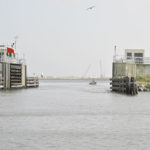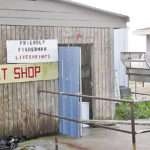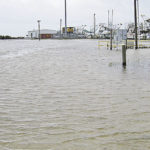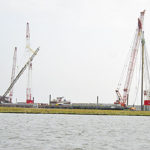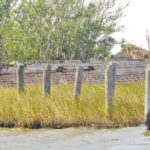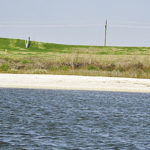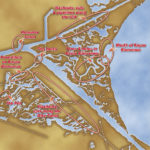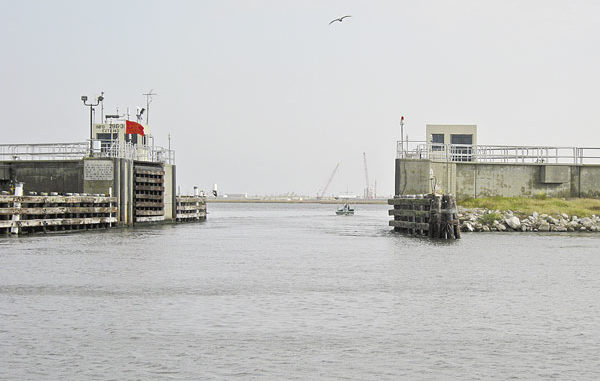
Rich in history and offering excellent fishing, Chalmette’s Bayou Bienvenue invites winter anglers.
The French named the wandering waterway “Bayou Bienvenue” (Bayou Welcome) probably because it was like a welcome mat, providing passage for ships entering from Lake Borgne almost to the very doorstep of New Orleans. The English happily took advantage of that welcome, and used the route when they invaded New Orleans in the famed 1814 Battle of New Orleans. Fortunately for Americans, the Brits were dealt a devastating blow in the area now known as the Chalmette Battlefield, and American liberties and independence were maintained.
As a kid, we considered the vast cypress swamp around Bayou Bienvenue our own personal playground. Hunting, fishing and crawfishing was everyday activity, and mink, otter, sable, nutria and alligator were common sights.
But everything changed after the construction of the infamous Mississippi River-Gulf Outlet. Salt water then funneled directly into the bayou from the Gulf, and quickly killed the cypresses, oaks and almost every other tree, as well as much of the shrub and grass. The wildlife vanished with the habitat, and for 40 years, the area has been decimated, eroded and virtually marinated in salt water.
The one thing that never left when the salt water came in was the fish. In fact, opinions are, the fishing action actually improved with the MRGO, particularly for trout and redfish.
The biggest trout I ever caught, 6.9 pounds, came from the MRGO at the Bulk Plant, and that whole area was well known for its annual spring run of oversized trout.
For several decades now, the Bayou Welcome area has consistently produced shrimp, crab, reds, specks, sheepshead, drum, flounder and everything else you’d expect in a coastal marsh. But that fact itself should have been a glaring caution sign: Chalmette was not supposed to be a coastal marsh!
It took the almost apocalyptic devastation of Hurricane Katrina to finally persuade the Corps of Engineers that closing the MRGO might be a good idea. And once they decided to close it off, they undertook two main projects to shut it down for good. The first was the well-publicized dam they built across the MRGO just below Bayou La Loutre in Hopedale.
The second is referred to not as a dam but as “The Wall” by locals. The corps is well into the construction of a huge wall spanning almost 2 miles in length that will cross the MRGO, the Gulf Intracoastal Waterway (ICW) and Bayou Bienvenue from the Michoud floodwall north of the ICW to the levee on the west side of the MRGO. Plans are to build a 150-foot-wide gate on the ICW and a 56-foot-wide gate at Bayou Bienvenue, both of which could be closed should a hurricane threaten the area.
Once completed, The Wall will tower up to 24 feet above the waterline, and carry a price tag of over a billion dollars. No gate will be constructed on the MRGO, so it will be walled off on both ends.
Just how effective it will all be if a hurricane strikes remains to be seen, but residents in Hopedale and Shell Beach already see strange and unexpected tidal behavior since the completion of the dam. Robert Campo at Campo’s Marina in Shell Beach says their docks now flood on almost any wind from the east.
“The water flows into Shell Beach from Lake Borgne, but now it takes a very long time for the water to leave because the new dam holds it back,” he said.
Furthermore, Campo says the water that is trapped behind the dam in Shell Beach takes so long to drain that it now stagnates, causing all the live bait in their bait tanks to die.
“Over 50 years, my family has kept bait alive on this bayou, but now we’re being forced to build an enclosed bait system to keep everything from dying,” he said.
The biggest concern from Shell Beach is the diminished tidal flow, some of which was anticipated. Lacking that direct channel to the Gulf, the water rises more slowly with the winds and tides. But that also means once the tide gets up, it also now drains out at a much slower rate.
The experts say this is natural and the tides and currents will return to draining the way things used to before the MRGO intruded and changed the hydrology of the area. Locals are concerned that if a hurricane pushes water from the Gulf up over the marsh into the region, it may take forever to drain. And now that The Wall is almost finished across the MRGO, similar effects are already being seen along Paris Road.
Jimmy Dixon Jr., over at Bait, Inc., says the water still rises with the tide and any east wind, but it drains much more slowly than ever before.
“My parking lot floods more frequently and it stays flooded much longer now, and that’ll only get worse with the completion of The Wall,” he said.
So far, the fishing action hasn’t really suffered, but only time will tell the rest of the story. Will the big trout patrol the MRGO along the Bulk Plant and Boh Brothers like they used to? Will the trout gang up in Seabrook, at the mouth of the Industrial Canal at Lake Pontchartrain, like they formerly did? And how will the shrimp be affected? Many trawlers made their livelihood just trawling in the MRGO. How will that be affected?
In a document published on Aug. 20, 2008, in anticipation of the closure of the MRGO in Chalmette, the corps stated that the closure would affect the fishery on both sides of The Wall and the gates on Bayou Bienvenue and the ICW.
“Possible impacts could be: Impeding active and passive transport of eggs and larvae across the barrier, blocking access to the habitat, and blocking access to prey items. These impacts could result in alterations of behavior, decreases in growth, and localized changes to the community structure,” the report stated.
“We’re all in a wait-and-see position here now,” Dixon said. “We’re hoping the fishing won’t be adversely affected, and so far, so good. Maybe we’ll even see more fish in the lake. But time will tell.”
Winter specks and reds
“The fish are eating up baits in the Pen,” I heard on my phone. I recognized the voice of Tony Cuccia, over at the Friendly Fisherman Bait Shop (318-422-9734), behind the motel in Chalmette.
He had promised to call me when the action turned on and here he was, living up to his word.
“Come on down, and we’ll try first to catch a few right off the dock,” he said. “If that doesn’t work, we’ll take the skiff out.”
Tony said his son, Tony Jr., reeled in 10 nice trout fishing from the dock the day before.
“This area isn’t really affected by the wind, so don’t worry about the forecast,” he said.
The forecast was for 20-knot winds, more than enough to cancel any fishing trip. But I had a backup plan in mind. I’d tow my boat down there, and drag Tony along for a quick tour and fishing trip. I wanted to see The Wall up close, and I wanted to wet a line in some of my old winter hotspots in the ICW. This would be my opportunity.
We fished for almost an hour off the dock with nary a bite, and all the while I watched boats trolling and drifting all across the Pen, which is the large, almost circular area of the marina. If you launch behind the motel ($7 launch fee, pay inside the store), you’re in it.
The whole area is fairly deep, and a channel drops down to over 20 feet across the middle of it. For whatever reason — deep water, bait or softer current — something about the Pen draws trout and even redfish year after year, particularly in the winter.
“It’s a great place for small boats and kayaks, and we see a lot of them in the winter,” Cuccia said. “When the bite is really on, we’ll see 20 to 30 boats in there, especially on weekends.”
But the action looked slow that morning in the Pen, so Cuccia suggested we take off in the boat, try elsewhere and come back later to try the Pen again. He dumped some live bait in the baitwell of the Sea Pro, and we headed out toward Bayou Bienvenue in search of winter specks.
Winter hotspots
• The Pen. “This is the easiest place to fish you’ll find,” Cuccia said. “Any size boat will do, and you can fish even under lousy conditions. I find the fishing gets better when it’s colder. You can anchor and fish the bottom with a sliding sinker or sliding cork, or you can drift if there’s not too many boats, or you can troll until you find them.
“Most people troll with the trolling motor, but some put lines out and pull Rat-L-Traps or soft baits. Whatever works.”
• Powerlines in Bayou Bienvenue. Cuccia says to either troll or anchor and fish near the powerline towers.
“This is a good spot to try tightlining plastics or fishing live bait or plastic under a cork,” he said.
• The Dike Canal. “Look for any drains from the marsh, and fish live bait on the bottom or under a cork for specks, reds and sheepshead,” he said.
• The Locks. Cuccia says to fish the downcurrent side on the bottom, using either a sliding-sinker rig or, better yet, a sliding-cork rig set about 10 feet deep.
“Live bait is the better option here,” he said.
The Locks at the Violet Canal are a good option also, he said.
• The Hot Water Canal. “They’re catching fish pretty consistently in the Hot Water Canal right now, and that will continue throughout the winter,” Cuccia said. “Boats tend to congregate pretty thick in there, so you have to go slow and be courteous. Live bait under a sliding cork is the best option because there is so much debris on the bottom.”
• Deep holes in Bayou Bienvenue. “Use your depth sounder and see where the drop-offs are in the turns and cuts, and try there on cold days,” Cuccia advised. “Get your bait to the bottom on a sliding-sinker rig or plastics worked on the bottom and up the ledges, slow.”
• Battery Bienvenue. The old fort-looking structure near the mouth of Bayou Bienvenue at Lake Borgne is actually an old battery built by Andrew Jackson (see sidebar).
“Toss your bait under a cork in the area up close to the wall,” Cuccia advised. “We catch reds and specks in there, especially on milder days or after the sun warms things up a bit.
• The mouth of Bayou Bienvenue at Lake Borgne. “Troll or anchor and try to locate the fish,” Cuccia advised. “Fish the bottom and under a cork, look for signs of bait in the water. Sometimes they’ll stack up pretty good right there.
• Pipelines and washouts along the ICW. Cuccia likes to anchor and cast live baits on a sliding-sinker or sliding-cork rig, or you can tightline plastics.
• Shell Bank along the ICW. “You can’t miss the long shell bank on the left-hand side as you travel down the ICW toward Bayou Thomas,” Cuccia said. “It’s a good place for reds and specks this time of year.
“You can try Bayou Thomas, or around the rubble that used to be the Castle, or Proctors Point — it all depends on how far you want to travel. But there’s no shortage of places to fish.
“And soon, you’ll be able to fish The Wall, once all the cranes and barges move. I’m sure the trout and white trout and probably everything else will stack up around both sides of The Wall, just like they’re doing down at the dam in Hopedale.”
We found the trout cooperative in the ICW at the pipeline canals, and managed to boat quite a few before those horrendous winds they predicted actually showed up and forced us in.
If you want a convenient and easy place to fish on a winter day, try Bienvenue. The welcome mat is out.
